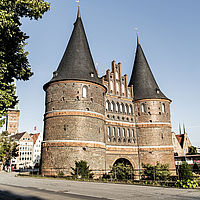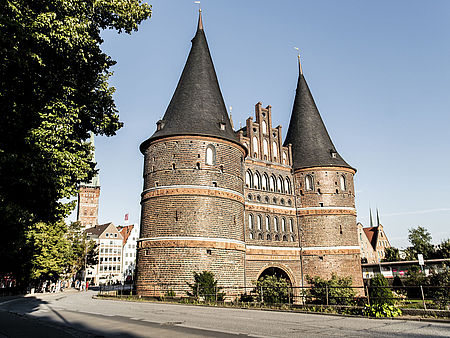
UNESCO World Heritage Site Lübeck
Lübeck was founded in 1143 as the first “occidental city on the Baltic coast”. It is a perfect example of the Hanseatic city family in the Baltic Sea region and is still today considered the “Queen of the Hanseatic League”. The city ensemble is considered one of the major testimonials to redbrick Gothic: its medieval layout with road network, road structure, quarter and plot structure is almost unchanged. In 1987, the historic city centre of Lübeck was thus named a UNESCO World Heritage site.
Since the Middle Ages, the seven towers of the churches have characterised the silhouette of the city. Thus, the St. Mary's Church is considered the mother of northern German brick basilicas. Over 70 places of worship in the entire Baltic region were modelled on this church. From the viewing platform on the tower of the St. Peter's Church, which is 50 metres high, you can enjoy a spectacular view of the old town. From here, your gaze travels across a sea of red roof tiles and brick – and if the weather is nice, all the way to Travemünde and the Baltic Sea.
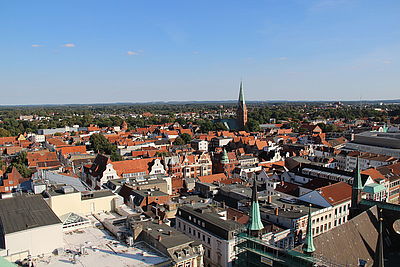
Buildings of the UNESCO
Did you know that the UNESCO protected area includes the major buildings in Lübeck, such as
- The building complex of the Town Hall,
- The Castle Monastery,
- The Koberg – a completely preserved quarter from the late 13th century – with St. Jacob's Church, Hospital of the Holy Spirit and the blocks between the Glockengiesser- and Aegidienstrasse,
- The quarter of the patrician houses from the 15th and 16th centuries between St. Petri and Lübeck Cathedral,
- The Holstentor and the salt storage tanks on the left bank of the river Trave.
Even the archaeological underground of the water-surrounded old town, with now three million findings, is part of the World Heritage site.
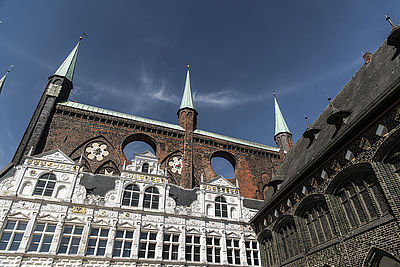
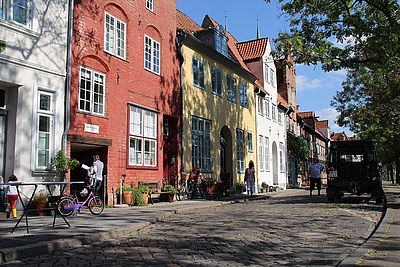
The magical world of courtyards and alleyways
An air of secrecy and adventure shrouds the alleys and courtyards: Visitors often need to leave familiar paths, watch their heads by entrances and exits and it can take a few minutes before eyes have adjusted to the somewhat dim surroundings of the peaceful oases. Many of the alleyways lead into another alley or catch visitors by surprise by depositing them into a familiar street. The courtyards and alleyways in Lübeck’s Old Town are witnesses of medieval architecture and due to the care and maintenance of the people of Lübeck they are still inhabited nowadays and often accessible for the public. Our recommendation: Spend your next Lübeck-holiday in a cosy alleyway-house! Some of the houses have been converted to homelike holiday apartments, that can be booked via our accommodation service.
Here is a little selection of the most famous alleyways:
Engelsgrube (Angel’s path) – Where the English were called Angels
Hardly any other street in the Old Town shows a bigger variety. The origin of this designation is not to be found in the heavenly spheres, but can be traced back to the Hanseatic name for the English, who docked their ships at the end of the street.
Hellgrüner und dunkelgrüner Gang
Through the low portal at the side of a baroque bourgeois house one enters the prettiest and cleanest of Lübeck’s alleyways: the Light and Dark Green Alley. Situated between Engelswisch and Untertrave and accessible from both ends, a forgotten world opens up, imparting a whiff of the old Lübeck: an interplay of narrow alleys, little shacks, courtyards like fields, alleys seeming to be blind and hidden exists.
Lüngreens Gang
is one of the few alleyways where the remaining two-storey houses from the first half of the 17th century are under monumental protection. Moreover, it is one of the few alleys connecting two streets (Gruben). For tourists it is an adventure to get from the angled ways on the end towards the Bäckergang to the straight Lüngreens Gang and then finding themselves emerging from the idyll into the Fischergrube.
